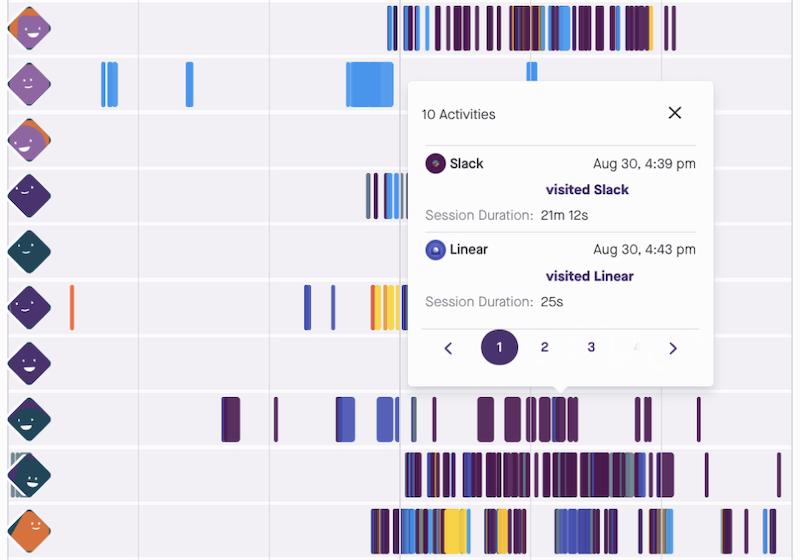Digital Work Analytics reporting
What is Digital Work Analytics, and How Can it Improve Remote Work?
Digital is the future of work in today’s remote-first world. But there are visibility problems we absolutely need to address.
Teams are using ever-evolving stacks of cloud-based SaaS tools to navigate their workdays, but they don’t have good insight or understanding into how everyone else is using those same tools. There are no internal usage benchmarks to compare with.
So why is this a problem?
All tools are acquired for a purpose. But if those tools aren’t being used as expected—or aren’t being used at all—that’s a problem.
The average company wastes more than $130,000 each year on underused, unused and duplicate SaaS tools. While SaaS management platforms exist for monitoring these solutions, the visibility and oversight they provide often live with a single department that may not understand what effective usage looks like across the unique teams within an organization.
And that’s not the only visibility issue. Because digital teams can’t see what everyone else is doing throughout the workday, internal communication frequency tends to creep up.
- More messages get sent.
- More meetings get scheduled.
- And people spend more time moving between apps trying to find the information they need to do their work.
It’s distracting, it’s exhausting and it’s costing workers an average of an hour and a half of work time each per day.
There’s a lack of understanding of what effective tech stack usage looks like for a team, but also the team is spinning its wheels trying to understand how the work is going in general.
We know there’s a problem. Now how do we get it under control?
Getting onboard with digital work analytics
The first step is to start gathering analytics on what digital work looks like for your team. But rather than putting one department or even individual in charge of managing the data for the entire organization, it’s time to make the data visible to everyone—data democratization.
Enable everyone on your team to see how everyone else is navigating the workday.

- Which apps are being used?
- When are they being used?
- By whom are they being used?
- And for how long?
Digital work analytics tools like Produce8 enable a fully transparent work environment in which everyone on a team, from the top down, can begin to see how that team’s people are using their technology and interacting with each other.

Working out loud like this helps teams start to pick out their tech usage patterns and any problematic communication habits.
Let’s get into that.
Start analyzing your team’s digital work data
By reviewing and analyzing your team’s tech usage over time, you can paint a picture of where time is being spent, how much time gets devoted to specific tech tools and how much time is actually leftover for deep work after things like meetings, messages and emails are out of the way.
So what can your team do with that information?

- Notice that calls are taking over the workdays? It might be time to make some changes in terms of meeting frequency and length—maybe even introduce something like no-meeting Fridays to give the team back more time to get things done.
- Found that several members of your team aren’t using a key piece of technology that’s helping others on the team achieve greater success? You might consider offering additional training or adjusting your onboarding process to emphasize the tool. Or maybe it’s not as important a tool as you initially thought.
- Shocked to see no one on your team is going more than 15 minutes in a day without getting pulled back into Slack? It’s probably time to make some setting and policy changes to reduce all the distractions your team is facing. Every time someone gets pulled away from what they’re working on and into Slack—or any app for that matter—time is lost to refocusing.
You might have felt some of these issues already, but seeing the indisputable data helps to prioritize where action is needed most.
It also helps ensure when you make changes, you’re going to measure results and see them through successful outcomes.
Create a better remote work environment for your team
Leveraging digital work analytics enables your team to create a feedback loop for continuous improvement. Because making changes is great, but measuring whether those changes made a positive impact is where the real magic happens.
With a digital work analytics tool, you can identify challenges in your team’s tech usage and work patterns, make changes and then re-analyze the data to see whether the changes you made had the desired outcome.
If the future of work is digital and increasingly remote, then it’s crucial for teams to focus on making sure that the environment is built for productivity and success. And creating more visibility and transparency so that problems can be identified and rectified is a huge step in the right direction.
Related Aritcles
Digital Work Analytics reporting
Produce8 Launches Essential Insights: Revolutionizing Digital Work Analytics for Businesses and MSPs
3 min read
Unlock great workdays
Wether you are collaborating with your team or solo tackling your day we can help you recover the most valuable asset, time.
